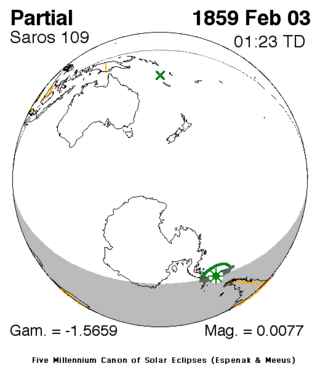Solar eclipse of February 3, 1859
A partial solar eclipse occurred on February 3, 1859 during summer. A solar eclipse occurs when the Moon passes between Earth and the Sun, thereby totally or partly obscuring the image of the Sun for a viewer on Earth. A partial solar eclipse occurs in the polar regions of the Earth when the center of the Moon's shadow misses the Earth.
| Solar eclipse of February 3, 1859 | |
|---|---|
 Map | |
| Type of eclipse | |
| Nature | Partial |
| Gamma | -1.5659 |
| Magnitude | 0.0077 |
| Maximum eclipse | |
| Coordinates | 62.4°S 72.1°W |
| Times (UTC) | |
| Greatest eclipse | 1:22:42 |
| References | |
| Saros | 109 (81 of 81) |
| Catalog # (SE5000) | 9184 |
It was the first of four partial eclipses that took place that year, two in a space of two months each, the next on was on March 4 and covered a small part of the Northern Hemisphere.[1] It was the last of solar saros 109.[2]
Description
The minor eclipse occurred mainly in the Pacific Ocean. All of the eclipse started at sunset, it started in the northern part of the Antarctic Peninsula in the area of the Antarctic Circle and finished at sunset west of Patagonia in South America.
It was visible in the northern part of Antarctica which had 24-hour daylight at that time, and a part of the southwesternmost portion of the Indian Ocean and a very tiny part of the Atlantic. The edge of the eclipse included the area dividing the Indian and the Atlantic oceans.
It showed about up to 1% obscurity in Antarctica and 4-5% in a part of the Pacific. The greatest eclipse was nearly about a third between Antarctica and South America at 62.4 S and 72.1 W at 1:22 UTC (8:36 PM local time on February 2).[1]
The subsolar marking was in the Pacific Ocean about a third of the way between New Caledonia and the Solomon Islands.
See also
- List of solar eclipses in the 19th century
- List of solar eclipses visible from Antarctica
References
- "Solar eclipse of February 3, 1859". NASA. Retrieved March 13, 2017.
- "Solar Saros 109". NASA. Retrieved March 13, 2017.
.jpg)
